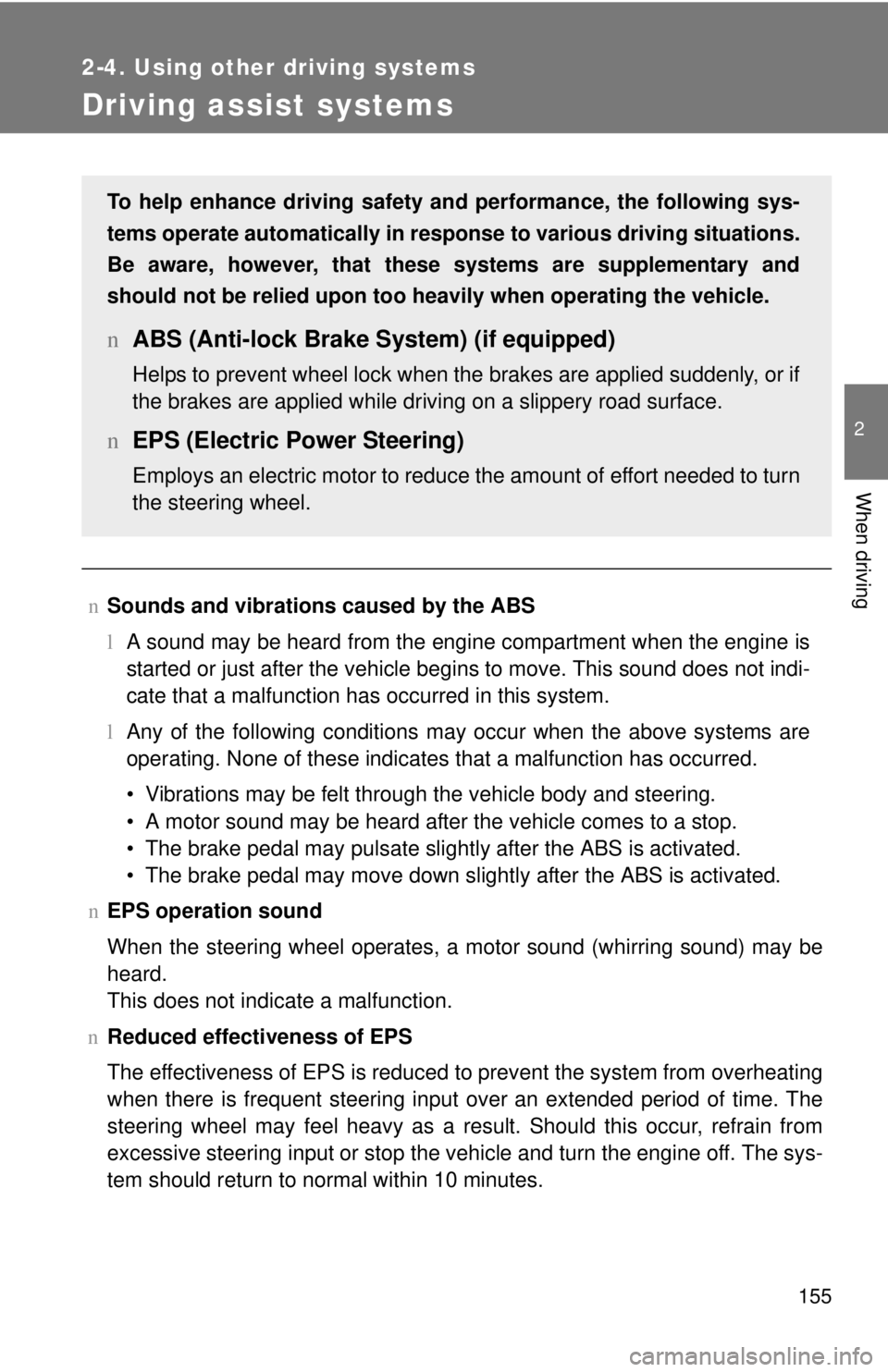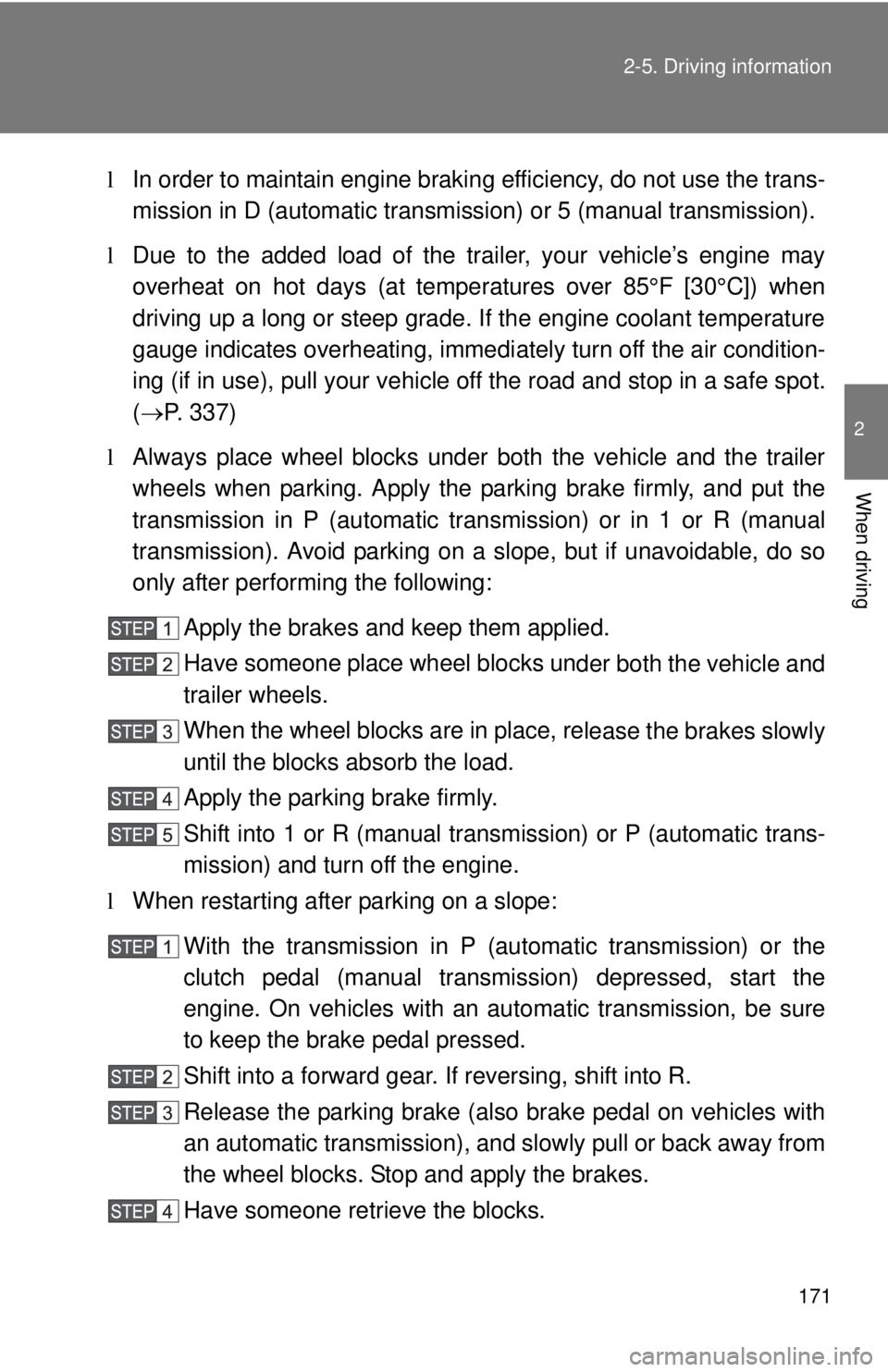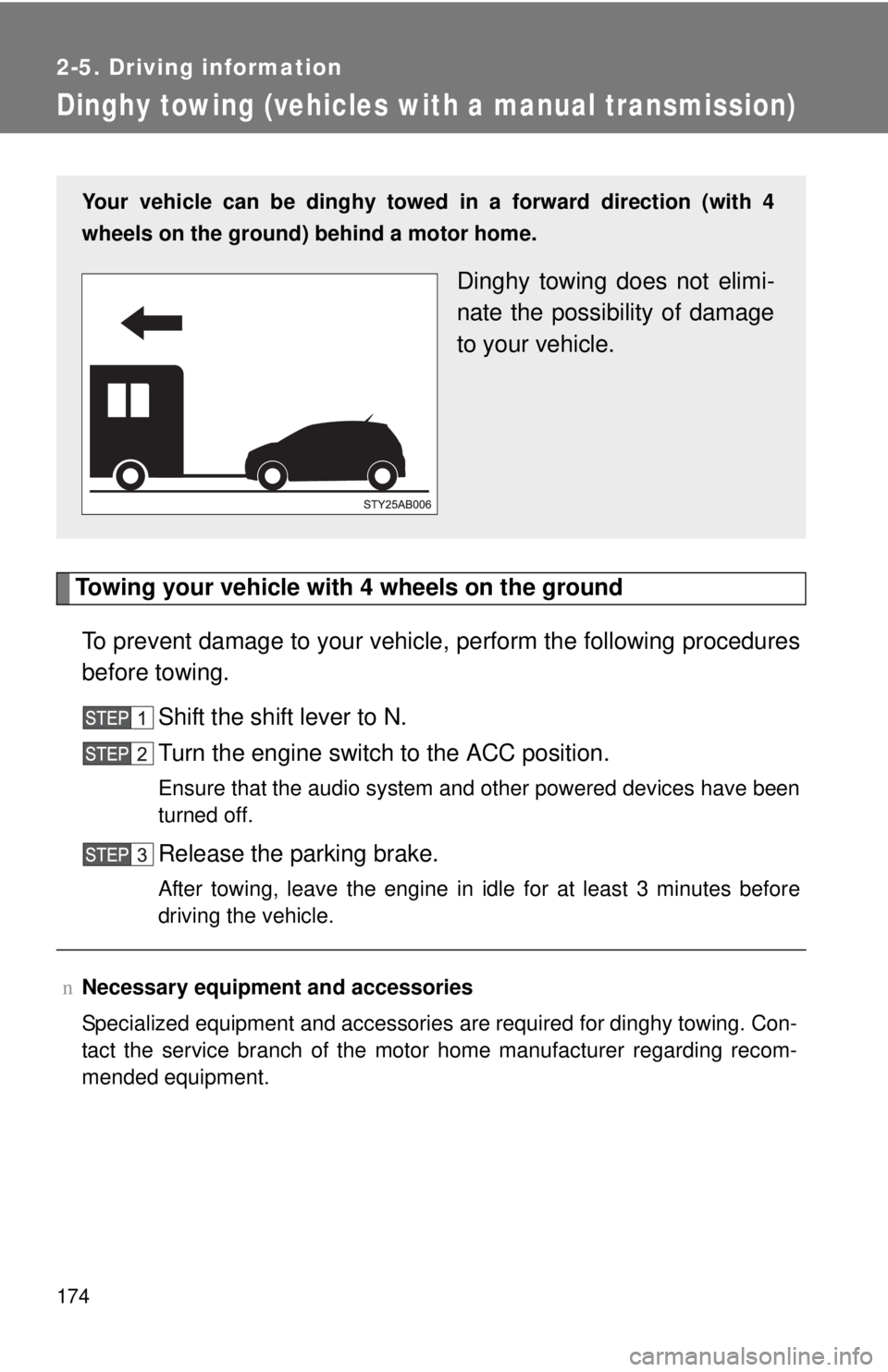2009 TOYOTA YARIS HATCHBACK brake
[x] Cancel search: brakePage 168 of 402

155
2-4. Using other driving systems
2
When driving
Driving assist systems
nSounds and vibrations caused by the ABS
l A sound may be hea
rd from the engine compartment when the engine is
started or just after the vehicle begins to move. This sound does not indi -
cate that a malfunction has occurred in this system.
l Any
of the following conditions may occur when the above systems are
operating. None of these indicates that a malfunction has occurred.
• Vibrations may be felt through the vehicle body and steering.
• A motor sound may be heard after the vehicle comes to a stop.
• The brake pedal may pulsate slightly after the ABS is activated.
• The brake pedal may move down slightly after the ABS is activated.
n EP
S operation sound
When the steering wheel operates, a motor sound (whirrin
g sound) may be
heard.
This does not indicate a malfunction.
n Reduced effectiveness of EPS
The effectiveness of EPS is reduced to prevent the system from overheating
when there
is frequent steering input over an extended period of time. The
steering wheel may feel heavy as a result. Should this occur, refrain from
excessive steering input or stop the vehicle and turn the engine off. The sys -
tem should return to normal within 10 minutes.
To help enhance driving safety a nd performance, the following sys-
tems operate automatically in res ponse to
various driving situations.
Be aware, however, that these systems are supplementary and
should not be relied upon too heavi ly when operating the vehicle.
nABS (Anti-lock Brake System) (if equipped)
Helps to prevent wheel lock when the brakes are applied suddenly, or if
the brakes are applied while driving on a slippery road surface.
nEPS (Electric Power Steering)
Employs an electric motor to reduce the amount of effort needed to turn
the steering wheel.
Page 174 of 402

161
2-5. Driving information
2
When driving
Winter driving tips
Carry out the necessary preparations and inspections before driving
the vehicle in winter. Always drive the vehicle in a manner appropri
-
ate to the prevailing weather conditions.
n Pre-winter preparations
lUse
fluids that are appropriate to the prevailing outside tem -
peratures.
• Engine oil
• Engine coolant
• Washer fluid
l Have a se
rvice technician inspect the level and specific grav -
ity of battery electrolyte.
l Have the veh
icle fitted with four snow tires or purchase a set
of tire chains for the front tires.
Ensure that all tires are the same size and brand, and that chains
match the size of the tires.
n Before driving the vehicle
Perform the following according to the driving conditions.
lDo
not try to forcibly open a window, scrape an outside rear
view mirror surface or move a wiper or outside rear view mir -
ror that is frozen. Pour warm water over the frozen area to
me
lt the ice. Wipe away the water immediately to prevent it
from freezing.
l T
o ensure proper operation of th e climate control system fan,
remove any snow that has accumulated on the air inlet vents
in front of the windshield.
l Remove a
ny ice that has accumu lated on the vehicle chassis.
l Pe
riodically check for and remove any excess ice or snow
that may have accumulated in the wheel well or on the
brakes.
Page 175 of 402

162 2-5. Driving information
Regulations on the use of snow chains
lRegulations regarding the use of tire chains vary according to loca-
tion and type of road. Alwa
ys check local regulations before install -
ing chains.
l Use SAE Class “
S” type radial tire chains, with the exception of
radial cable chains or V-bar type chains.
• Install the chains on the front tires.
• Refer to the explanation that co
mes with the tire chains for
installation instructions.
l Re
tighten the chains after drivi ng 1/4 - 1/2 mile (0.5 - 1.0 km).
nSnow chain installation
Observe the following precautions when installing and removing chains.
l Inst
all and remove tire chains in a safe location.
lInst
all tire chains on the front tires only. Do not install tire chains on the
rear tires.
l Inst
all the tire chains on front tires as tightly as possible.
lInst
all tire chains following the instructions provided in the accompanying
instructions.
l If
wheel ornaments are used, they will be scratched by the chain band,
so remove the ornaments before putting on the chains. ( →P. 320)
nWhen driving the vehicle
Accelerate the vehicle slowly and drive at a reduced speed suit -
able to road conditions.
n When
parking the vehicle
Park the vehicle and move the shift lever to P (automatic trans -
mission) or to 1 or R (manual transmission) without setting the
p
arking brake. The parking brak e may freeze up, preventing it
from being released.
Page 182 of 402

169
2-5. Driving information
2
When driving
Trailer towing tips
Your vehicle will handle differently
when towing a trailer. The three
main causes of vehicle-trailer ac cidents are driver error, excessive
speed and improper trailer loading. Keep these in mind when towing.
l Before st
arting out, check the trailer’s light and the vehicle-trailer
connections. Recheck after driving a short distance.
l Practice tu
rning, stopping and revers ing with the trailer attached in
an area away from traffic until y ou become accustomed to the feel
of the vehicle.
NOTICE
n When installing a trailer hitch
Use only the position recommended by your Toyota dealer. Do not install the
trailer hitch on the bumper; this may cause body damage.
n Brakes
Toyota recommends trailers with brakes that conform to any applicable fed-
eral and state/provincial regulations.
n Safety chain
A safety chain must always be used between the towing vehicle and the
trailer. Leave sufficient slack in the chain for turns. The chain should cross
under the trailer tongue to prevent the tongue from dropping to the ground in
the case that it becomes damaged or separated. For the correct safety chain
installation procedure, ask your Toyota dealer.
n Do not directly splice trailer lights
Directly splicing may damage your vehicle’s electrical system and cause a
malfunction.
Page 183 of 402

170 2-5. Driving information
lReversing with a trailer attached is difficult and requires practice.
Grip the bottom of the steering wheel and move your hand to the
left to move the trailer to the left. Move your hand to the right to
move the trailer to the right. (This is generally opposite to reversing
without a trailer attached.) Avoid sharp or prolonged turning. Have
someone guide you when reversing to reduce the risk of an acci -
dent.
l As stopp
ing distance is increased when towing a trailer, vehicle-to-
vehicle distance should be increased. For each 10 mph (16 km/h)
of speed, allow at least o ne vehicle and trailer length.
l A
void sudden braking as you may skid, resulting in jackknifing and
loss of control. This is especiall y true on wet or slippery surfaces.
l A
void jerky starts or sudden acceleration. Vehicles with a manual
transmission, prevent excessive clut ch slippage by keeping engine
rpm low and not racing the engine. Always start out in first gear.
l A
void jerky steering and sharp turns, and slow down before mak -
ing a turn.
l Note
that when making a turn, th e trailer wheels will be closer than
the vehicle wheels to the inside of the turn. Compensate by making
a larger than normal turning radius.
l Cr
osswinds and rough roads will adversely affect handling of your
vehicle and trailer, causing sway. Periodically check the rear to
prepare for being passed by large trucks or buses, which may
cause your vehicle and trailer to sway. If swaying occurs, firmly grip
the steering wheel, reduce speed immediately but gradually, and
steer straight ahead. Never increase speed. If you make no
extreme correction with the steeri ng or brakes, your vehicle and
trailer will stabilize.
l T
ake care when passing other v ehicles. Passing requires consider -
able distance. After passing a vehi cle
, do not forget the length of
your trailer, and be sure you have plenty of room before changing
lanes.
Page 184 of 402

171
2-5. Driving information
2
When driving
l
In order to maintain engine braki ng efficiency, do not use the trans -
mission in D (automatic transmiss ion
) or 5 (manual transmission).
l Du
e to the added load of the trailer, your vehicle’s engine may
overheat on hot days (at temperatures over 85°F [30°C]) when
driving up a long or steep grade. If the engine coolant temperature
gauge indicates overheating, immedi ately turn off the air condition-
ing (if in use), pull your vehicle off the road and stop in a safe spot.
( → P. 3 3 7 )
l Alw
ays place wheel blocks under both the vehicle and the trailer
wheels when parking. Apply the parking brake firmly, and put the
transmission in P (automatic transmission) or in 1 or R (manual
transmission). Avoid parking on a slope, but if unavoidable, do so
only after performing the following:
Apply the brakes and keep them applied.
Have someone place wheel blocks un
der both the vehicle and
trailer wheels.
When the wheel blocks are in pl ace, re
lease the brakes slowly
until the blocks absorb the load.
Apply the parking brake firmly.
Shift into 1 or R (manual transmission) or P (automatic trans -
mission) and turn off the engine.
l Whe
n restarting after parking on a slope:
With the transmission in P (automatic transmission) or the
clutch pedal (manual transmission) depressed, start the
eng
ine. On vehicles with an au tomatic transmission, be sure
to keep the brake pedal pressed.
Shift into a forward gear. If reversing, shift into R.
Release the parking brake (also b
rake pedal on vehicles with
an automatic transmission), and sl o
wly pull or back away from
the wheel blocks. Stop and apply the brakes.
Have someone retrieve the blocks.
Page 185 of 402

172 2-5. Driving information
CAUTION
nTo avoid an accident
lDo not exceed 45 mph (72 km/h) or posted towing speed limit, whichever
is lower. As instability (swaying) of the towing vehicle-trailer combination
increases as speed increases, exceeding 45 mph (72 km/h) may cause
loss of control.
l Slow down and downshift before descending steep or long downhill
grades. Do not make sudden downshifts.
l Avoid holding the brake pedal down too long or too frequently. This could
cause the brakes to overheat and result in reduced braking efficiency.
Page 187 of 402

174
2-5. Driving information
Dinghy towing (vehicles with a manual transmission)
Towing your vehicle with 4 wheels on the ground
To prevent damage to your vehicle, perform the following procedures
before towing.
Shift the shift lever to N.
Turn the engine switch to the ACC position.
Ensure that the audio system and other powered devices have been
turned off.
Release the parking brake.
After towing, leave the engine in idle for at least 3 minutes before
driving the vehicle.
nNecessary equipment and accessories
Specialized equipment and accessories are required for dinghy towing. Con -
tact the service branch of the motor home manufacturer regarding recom -
mended equipment.
Your vehicle can be dinghy towed in a forward direction (with 4
wheels on the ground) behind a motor home.
Dinghy towing does not elimi -
nate the possibility of damage
t
o your vehicle.